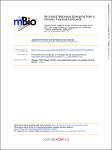An insect nidovirus emerging from a primary tropical rainforest.
Zirkel, Florian
Kurth, Andreas
Quan, Phenix-Lan
Briese, Thomas
Ellerbrok, Heinz
Pauli, Georg
Leendertz, Fabian
Lipkin, W. Ian
Ziebuhr, John
Drosten, Christian
Junglen, Sandra
Tropical rainforests show the highest level of terrestrial biodiversity and may be an important contributor to microbial diversity. Exploitation of these ecosystems may foster the emergence of novel pathogens. We report the discovery of the first insect-associated nidovirus, tentatively named Cavally virus (CAVV). CAVV was found with a prevalence of 9.3% during a survey of mosquito-associated viruses along an anthropogenic disturbance gradient in Côte d'Ivoire. Analysis of habitat-specific virus diversity and ancestral state reconstruction demonstrated an origin of CAVV in a pristine rainforest with subsequent spread into agriculture and human settlements. Virus extension from the forest was associated with a decrease in virus diversity (P < 0.01) and an increase in virus prevalence (P < 0.00001). CAVV is an enveloped virus with large surface projections. The RNA genome comprises 20,108 nucleotides with seven major open reading frames (ORFs). ORF1a and -1b encode two large proteins that share essential features with phylogenetically higher representatives of the order Nidovirales, including the families Coronavirinae and Torovirinae, but also with families in a basal phylogenetic relationship, including the families Roniviridae and Arteriviridae. Genetic markers uniquely conserved in nidoviruses, such as an endoribonuclease- and helicase-associated zinc-binding domain, are conserved in CAVV. ORF2a and -2b are predicted to code for structural proteins S and N, respectively, while ORF3a and -3b encode proteins with membrane-spanning regions. CAVV produces three subgenomic mRNAs with 5' leader sequences (of different lengths) derived from the 5' end of the genome. This novel cluster of mosquito-associated nidoviruses is likely to represent a novel family within the order Nidovirales. IMPORTANCE Knowledge of microbial diversity in tropical rainforests is sparse, and factors driving the emergence of novel pathogens are poorly understood. We discovered and mapped the spread and genetic evolution of a novel mosquito nidovirus from a pristine rainforest to human settlements. Notably, virus diversity decreased and prevalence increased during the process of spreading into disturbed habitats. The novel virus, tentatively termed Cavally virus, contains genetic features common to members of the order Nidovirales (families Coronaviridae, Arteriviridae, and Roniviridae), including conservation of the replicase machinery and expression of subgenomic RNA messages, has a basal phylogenetic relationship to the family Coronaviridae, and clearly differs from the established nidovirus families. Inclusion of this putative novel family in the nidovirus phylogeny suggests that nidoviruses may have evolved from arthropods.
No license information

